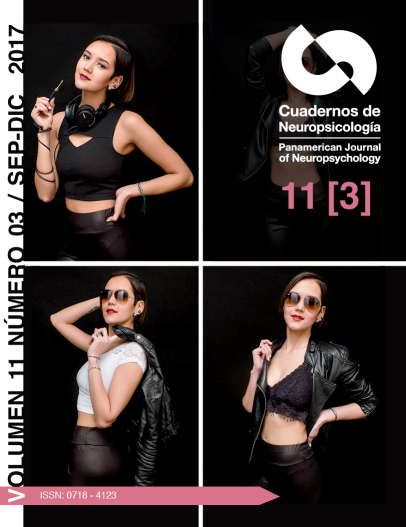Análisis de las Propiedades Psicométricas de la Escala Crespo-Bujosa de SÃntomas Neurológicos Discretos
Abstract
Resumen
El propósito de este trabajo es presentar la Escala Crespo-Bujosa de SÃntomas Neurológicos Discretos. La misma tiene como propósito realizar un examen rápido de la sintomatologÃa que experimenta una persona con indicadores neurológicos reales. Los SÃntomas Neurológicos Discretos (SND) son definidos como irregularidades neurológicas leves pero inequÃvocas de las funciones sensorio-motrices primarias. Estos indicadores conductuales y motores no tienen necesariamente una relación sistemática con una neuropatologÃa. Sin embargo, puede indicar deterioro neurológico, inmadurez en el desarrollo o un intermedio en un continuo dentro de un proceso de lesión. Se realizó un estudio transversal con una muestra por disponibilidad que estuvo compuesta por 411 participantes mayoritariamente por mujeres (77.7%). Las edades de los participantes oscilan entre 18 y 94 años. El 43% de los participantes habÃan recibido un diagnóstico neurológico (ej. Epilepsia o Migraña, etc.) o neuropsicológico (ej. ADHD). Al realizar los análisis de ecuaciones estructurales, se encontró que el modelo tiene buen ajuste para evaluar el constructo de SND. El instrumento presentó un buen ajuste y fiabilidad. Cada una de las sub-escalas mide una dimensión distinta de SND sin redundancia entre las sub-escalas del instrumento. Los análisis de discriminación de los Ãtems oscilaron entre .55 - .78, con una varianza explicada R2 en los Ãtems por los factores de entre .46 y .74. Los Ãndices de discriminación, estuvieron sobre el mÃnimo recomendado de .30. La escala final agrupa los sÃntomas en tres dimensiones: a) sÃntomas neurocognitivos, b) sÃntomas somáticos, y c) sÃntomas psicológicos.
 Palabras Clave: SÃntomas Neurológicos; Escala; neuropsicologÃa.
Â
AbstractÂ
The purpose of this project is to present the Escala Crespo-Bujosa de SÃntomas Neurológicos Discretos (Crespo-Bujosa Neurological Soft Sign Scale). It has the purpose of carrying out a quick screening of the symptoms experimented by individuals with real neurologic indicators. Neurological Soft Signs (NSS) are defined as mild neurological irregularities, however, unequivocal, of primary sensory-motor functions. This behavioral and motor indicators do not necessarily have a systematic relation with a neuropathology. However, they may indicate neurological deterioration, developmental immaturity or an intermediate in the continuum in a lesion process. A transversal study was carried out with sample of 411 participants per disponibility with a majority of them being females (77.7%). The ages of the participants ranged from 18 to 94 years. 43% of the participants had received a neurological diagnosis (e.g. Epilepsy or Migraine, etc.) or neuropsychological (e.g. ADHD). Through structural equations it was found that the model has a good adjustment to evaluate the construct of NSS. The instrument shower a good adjustment and reliability. Each sub-scale measures a different dimension of NSS without redundancy between them. The item discrimination analysis ranged between .55 - .78 with a explained variance R2 in the items per factor between .46 and .74. The discrimination indexes were at the minimum recommended of .30. The final scale groups the symptoms in three dimensions: a) neurocognitive symptoms, b) somatic symptoms and c) psychological symptoms.
Keywords: Neurologis Soft Signs; Scale; neuropsychology
Â
ResumoÂ
O propósito deste trabalho é apresentar a Escala Crespo-Bujosa de SÃntomas Neurológicos Discretos. Esta têm como propósito realizar um exame rápido da sintomatologÃa que experimenta uma perssoa com indicadores neurológicos reais. Os SÃntomas Neurológicos Discretos são definidos como irregularidades neurológicas leves mas inequÃvocas das funções sensoriais-motoras primárias. Estes indicadores conductuais e motores não têm necesáriamente uma relação sistemática com uma neuropatologia. Sem embargo, pode indicar deterioro neurológico, inmadurez no desenvolvimento ou um intermedio num continuo dentro de um processo de lisão. Se realuzou um estudo transversal com uma amostra por disponibilidade composta por 411 participantes cuja maioria foram mulheres (77.7%). As idades dos participantes esteve entre 18 e 94 anos. O 43% dos participantes tinha recebido um diagnóstico neurológico (p.e. Epilepsia ou Enxaqueca, etc.) ou neuropsicológico (p.e. ADHD). Ao realizar o anélise de equações estruturais, achamos que o modelo têm um bom ajuste para avaliar o construto de SND. O instrumento apresentou um bom ajuste e fiabilidade. Cada sub-escalas mide uma dimensção distinta de SND sem redundância entre as sub-escalas do instrumento. Os análisis de discriminação dos Ãtens oscilaram entre .55 - .78, com uma varianza explicada R2 nos Ãtens pelos factores de entre .46 y .74. Os Ãndices de discriminação, estuvieram sobre o mÃnimo recomendado de .30. A escala final agrupa os sÃntomas en três dimenções: a) sÃntomas neurocognitivos, b) sÃntomas somáticos, e c) sÃntomas psicológicos.
Palavras Chave: Sinais Neurológicos Sutis; Escala; neuropsicológica.
Downloads
How to Cite
Issue
Section
License
Articles published in this journal are protected under the Creative Commons Attribution-NonCommercial-ShareAlike 4.0 International (CC BY-NC-SA 4.0) license. This means that authors retain full rights over their research and publications at all times. As a journal, we fully respect and promote the principles of open access established by this license, allowing the work to be shared, adapted, and distributed for non-commercial purposes, provided that appropriate credit is given to the authors and any derivative works are licensed under the same terms.
Authors are responsible for obtaining the required permission when they wish to reproduce part of the material (figures, etc.) from other publications.
Likewise, CNPs allows authors to host in their personal sites or other repositories that they deem convenient the Final and Definitive Version of the published article with the format assigned by the journal. In no case do we allow access to preprints of the article under evaluation or already published.
When submitting an article to CNPs you are aware that all the contents of CNPs are under a Creative Commons License. In which it is allowed to copy and share the contents freely, always making reference to the origin of the publication and its author.





